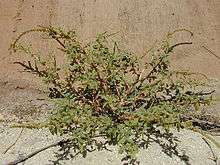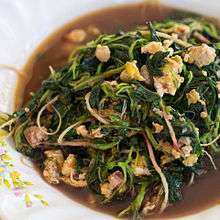Amaranthus spinosus
Amaranthus spinosus, commonly known as the spiny amaranth,[1] spiny pigweed, prickly amaranth or thorny amaranth, is a plant is native to the tropical Americas, but is present on most continents as an introduced species and sometimes a noxious weed. It can be a serious weed of rice cultivation in Asia.[2]
| Amaranthus spinosus | |
|---|---|
 | |
| Scientific classification | |
| Kingdom: | Plantae |
| Clade: | Tracheophytes |
| Clade: | Angiosperms |
| Clade: | Eudicots |
| Order: | Caryophyllales |
| Family: | Amaranthaceae |
| Genus: | Amaranthus |
| Species: | A. spinosus |
| Binomial name | |
| Amaranthus spinosus | |
Uses
Dye use
In Khmer language, it is called pti banlar and in Vietnamese giền and its ash was historically used as a grey cloth dye.
Food use

Like several related species, A. spinosus is a valued food plant in Africa.[3] It is valued also in Thai cuisine, where it is called phak khom (Thai: ผักขม). In Tamil, it is called mullik keerai. In Sanskrit, it is called tanduliyaka. It is used as food in the Philippines, where it is called kulitis. The leaves of this plant, known as massaagu in the Maldivian language, have been used in the diet of the Maldives for centuries in dishes such as mas huni.[4] In Mexico, it is among the species labelled Quelite quintonil in Mexican markets. In Bangladesh it is called "Katanote (কাটানটে)". In Manipuri, it is called" Chengkrook" and is used as food in stir-fry and in broths mixed with other vegetables. In Mauritius it is called "Brède malbar". The seeds are eaten by many songbirds.[5]
Traditional medicine
In the folk medicine of India, the ash of fruits of Amaranthus spinosus is used for jaundice.[6] Water extracts from its roots and leaves have been used as a diuretic in Vietnam.[7]
References
- "Amaranthus spinosusaccessdate=7 January 2016". Natural Resources Conservation Service PLANTS Database. USDA.
- Caton, B. P.; M. Mortimer; J. E. Hill (2004). A practical field guide to weeds of rice in Asia. International Rice Research Institute. pp. 20–21. ISBN 9789712201912.
- Grubben, G.J.H. & Denton, O.A. (2004) Plant Resources of Tropical Africa 2. Vegetables. PROTA Foundation, Wageningen; Backhuys, Leiden; CTA, Wageningen.
- Xavier Romero-Frias, The Maldive Islanders, A Study of the Popular Culture of an Ancient Ocean Kingdom. Barcelona 1999, ISBN 84-7254-801-5
- Niering, William A.; Olmstead, Nancy C. (1985) [1979]. The Audubon Society Field Guide to North American Wildflowers, Eastern Region. Knopf. p. 320. ISBN 0-394-50432-1.
- Tewari, Devesh; Mocan, Andrei; Parvanov, Emil D; Sah, Archana N; Nabavi, Seyed M; Huminiecki, Lukasz; Ma, Zheng Feei; Lee, Yeong Yeh; Horbańczuk, Jarosław O; Atanasov, Atanas G (2017). "Ethnopharmacological Approaches for Therapy of Jaundice: Part I". Frontiers in Pharmacology. 8. doi:10.3389/fphar.2017.00518. PMC 5559545. PMID 28860989.
- Tanaka, Yoshitaka; Van Ke, Nguyen (2007). Edible Wild Plants of Vietnam: The Bountiful Garden. Thailand: Orchid Press. p. 22. ISBN 9745240893.
External links